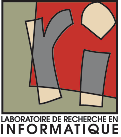Side-Crossing Menus: Enabling Large Sets of Gestures for Small Surfaces
Résumé
Supporting many gestures on small surfaces allows users to interact remotely with complex environments such as smart homes, large remote displays, or virtual reality environments, and switching between them (e.g., AR setup in a smart home). Providing eyes-free gestures in these contexts is important as this avoids disrupting the user's visual attention. However, very few techniques enable large sets of commands on small wearable devices supporting the user's mobility and even less provide eyes-free interaction. We present Side-Crossing Menus (SCM), a gestural technique enabling large sets of gestures on a smartwatch. Contrary to most gestural techniques, SCM relies on broad and shallow menus that favor small and rapid gestures. We demonstrate with a first experiment that users can efficiently perform these gestures eyes-free aided with tactile cues; 95% accuracy after training 20 minutes on a representative set of 30 gestures among 172. In a second experiment, we focus on the learning of SCM gestures and do not observe significant differences with conventional Multi-stroke Marking Menus in gesture accuracy and recall rate. As both techniques utilize contrasting menu structures, our results indicate that SCM is a compelling alternative for enhancing the input capabilities of small surfaces.
Domaines
Interface homme-machine [cs.HC]
Fichier principal
 ISS20-scm.pdf (6.63 Mo)
Télécharger le fichier
ISS20-scm.pdf (6.63 Mo)
Télécharger le fichier
 ISS20-scm-thumb.jpg (5.26 Ko)
Télécharger le fichier
ISS20-scm.mp4 (44.97 Mo)
Télécharger le fichier
ISS20-scm-thumb.jpg (5.26 Ko)
Télécharger le fichier
ISS20-scm.mp4 (44.97 Mo)
Télécharger le fichier
| Origine | Fichiers produits par l'(les) auteur(s) |
|---|
| Format | Figure, Image |
|---|
Loading...

